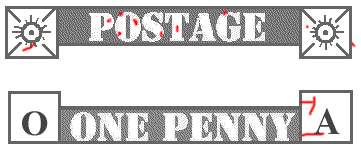|
Plate 6 |
Plate 6 |
|
Plate 7 |

Plate 11 |
Re-Entries
These are marks left on the stamp due to the roller being applied to the plate a second time but not placing the second impression in exactly the same position as the original impression. This is mos frequently found on the corner squares, margins and values. Figure 1. shows examples of re-entries:
Examples of re-entry on Penny Black Plates 6, 7, and 11
|
Plate 6 |
Plate 6 |
|
Plate 7 |

Plate 11 |
The re-entry, when placed directly upon the previous impression, will show little or no evidence of repair. When the new impression is successfully laid on top of the previous impression it is called a coincidental re-entry. If a new impression is laid down upon a previous impression, and the alignment is slightly off, the new impression marks in corner squares, margins and values. This is called non-coincidental re-entry. As can be seen from the above illustrations, the re-entries are normally far from dramatic, and can even go unnoticed by the untrained eye. There are very few re-entries which have a dramatic impact on the appearance of the stamp. They are in fact usually only of value for the Plater's identification of the stamp.